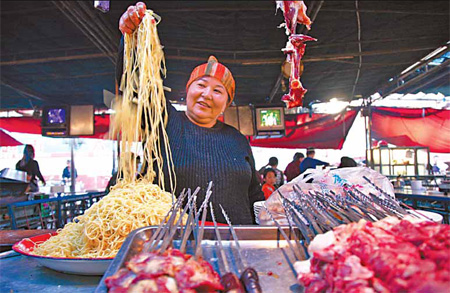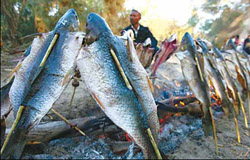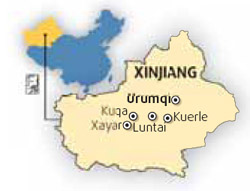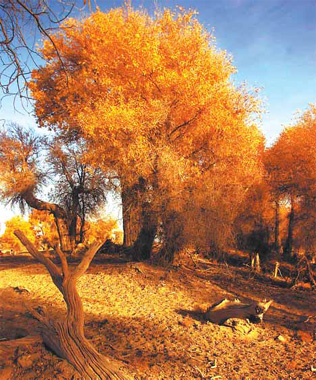A poplar destination: Xayar County
It's near midnight in Xayar county town, Xinjiang Uygur autonomous region, but the night market is still bustling with people.
 |
|
A Uygur woman prepares noodles at a bazaar in Xayar county town. |
More than 100 food stands are doing brisk business, selling Muslim delicacies from the region, as well as dishes from other parts of the country, such as jiaozi and noodles in clay pots.
|
|
|
Luobu dancers wait for their turns to perform for visitors at a village in Kuqa county. |
Most Xayar residents are Muslim Uygurs, and they like to sit in the market on folding chairs, watching soap operas in the Uygur language on TV.
In October, a poplar tree festival was held to promote tourism. Diversifolious poplar, from the deserts of Xinjiang, are famed for living for 1,000 years, dying without falling down for 1,000 years, and falling down without rotting for another 1,000 years.
Diversifolious popular trees mainly grow along the riverbanks of the Tarim River, which is the principal river in Xinjiang and snakes more than 2,000 km.
 |
|
Roast Tarim fish |
Here, in the forests of poplar trees, visitors can enjoy a meal of roast Tarim fish and crispy nang (Xinjiang pancake or bread), while listening to traditional music played by Uygur musicians.
The Xayar poplar tree festival will run until this December and is part of the First China Xinjiang International Tourism and Photography Festival, and Xinjiang International Poplar Tree Festival, held from mid-October to December.
The two festivals attracted nearly 100 photographers from all over the country, including China Daily photographer Lu Zhongqiu. They traveled to Urumqi, Kuerle, Yuli, Luntai, Kuqa and Xayar, and recorded the region's spectacular natural scenery and ethnic cultures.

In Yuli county, they visited a village of Luobu people at the edge of the Taklamakan Desert, the second largest desert in the world, and got a glimpse of their traditional lifestyle, which relied on the desert, poplar trees and Tarim River.
In Luntai county, they witnessed a group wedding ceremony in a forest of poplar trees. Luntai has the country's largest nature reserve for diversifolious popular trees, with an area of 70 sq km.
According to Chi Chongqing, head of Xinjiang's tourism administration, more than 90 percent of the diversifolious popular trees in the world are distributed along the Tarim River in Xinjiang.
"Although tourism in Xinjiang was hurt by the Urumqi riot, it will soon be restored and prosper just like the poplar trees living in the desert," he says.
|
|
|
In the autumn, the golden leaves and red brown trunks of the poplar trees, set off by yellow sand dunes and the blue sky, create an outstandingly beautiful and distinctive scene. |
 0
0 









Comments